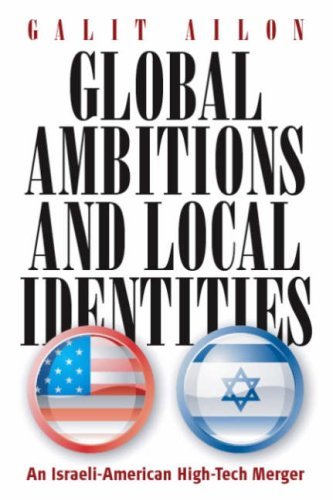Global Ambitions and Local Identities: An Israeli-American High-Tech Merger
Ailon, Galit
Berghahn Books, Oxford
2007
1845451945 (hb)
 Galit Ailon illustrates the significance of 'otherness' in identity construction in global work environments. Drawing on a year-long participatory fieldwork between 1998 and 1999 in an Israeli software company, pseudo-named Isrocom that provides telecommunication solutions all over the world, Ailon demonstrates how Isrocom´s employees socially (re)construct their identities in the face of stimulus coming from the merger partners, the pseudo-named Amerotech. Due to the fieldwork location, Tel Aviv, Ailon only studies the Israeli identity project. This is justified as the merger of two companies is actually a de facto take over of Amerotech by Isrocom. Taking over an American company in the eyes of Isrocom employees represents the triumph of David over the Goliath of globalisation and provides an important theme to the identity project. However, this theme or the identity project in general do not emanate from the managers of Isrocom. In this respect, Ailon challenges the specific literature from organisational studies that managers are active creators of organisational identity and workers are passive observers of it. She substantiates her challenge by demonstrating how other identities of Isrocom employees come to social fore during organisational identity (re)construction in the merger process and at times challenge the identity project that revolves around being Israeli and 'superior' organisational tenets that come with it. Thus, the identity project is an open-ended, multi-authored process that runs in the background of daily activities in Isrocom.
Galit Ailon illustrates the significance of 'otherness' in identity construction in global work environments. Drawing on a year-long participatory fieldwork between 1998 and 1999 in an Israeli software company, pseudo-named Isrocom that provides telecommunication solutions all over the world, Ailon demonstrates how Isrocom´s employees socially (re)construct their identities in the face of stimulus coming from the merger partners, the pseudo-named Amerotech. Due to the fieldwork location, Tel Aviv, Ailon only studies the Israeli identity project. This is justified as the merger of two companies is actually a de facto take over of Amerotech by Isrocom. Taking over an American company in the eyes of Isrocom employees represents the triumph of David over the Goliath of globalisation and provides an important theme to the identity project. However, this theme or the identity project in general do not emanate from the managers of Isrocom. In this respect, Ailon challenges the specific literature from organisational studies that managers are active creators of organisational identity and workers are passive observers of it. She substantiates her challenge by demonstrating how other identities of Isrocom employees come to social fore during organisational identity (re)construction in the merger process and at times challenge the identity project that revolves around being Israeli and 'superior' organisational tenets that come with it. Thus, the identity project is an open-ended, multi-authored process that runs in the background of daily activities in Isrocom.
The book is organised in to seven chapters. Chapter One sets out the rationale of the study and methodological choice after vividly describing the first day of the merger and the 'wedding celebration' the very place where an identity project among some Isrocom employees surfaced. Chapter Two gives a brief history of Isrocom and the merger and gives a taste of how transformations it has brought have led to problems which have kept the identity project alive. Foremost among these transformations are merging and closure of several departments and the consequent co-habitation of Israelis and Americans. The co-habitation happens through various communication events such as video conferencing, email correspondence, and face-to- face interactions, and through representations of the merger partners on bulletin boards, intranet programmes, and during informal discussions about Americans in Isrocom. Chapters Three and Four detail communication events and representation acts and their enactment of identity project respectively. The following chapters, Five and Six demonstrate how multiple sources of identity such as nationality, religious beliefs, occupational status and gender mold organisational identity construction and at times challenge the seemingly unified Israeli organisational identity that surface in communication and representation events. Chapter Seven concludes the book by reviewing Ailon´s findings and their implications for organisational studies' take on identity in global work settings.
All in all, Ailon´s book shows us that organisational identity is a fluid matter and is shaped by social divisions such as class (organisational hierarchy), gender, religion, and ethnicity, that cut across organisational and national scenes. The consequence of this is that there can be no neatly defined essentialist accounts of national organisational identity as proposed by some cross-cultural organisational research on mergers and acquisitions. Another important and related consequence of the book is that organisational identities are not necessarily either global or national in mutually exclusive manner. They are a blend of both and they are shaped by social divisions employees belong to. One common feature of all the identity accounts provided by Ailon is that everyone is at liberty to come up with their unique identity construct. However, this construct is very much shaped by the distant other, the 'Americans' and thus resembles each other to large extent. In this vein, it would be interesting to see how this multitude of identity projects has affected the merger process, especially after Ailon´s fieldwork. Thus, an additional chapter that draws on the current situation in the merged company would enhance the book´s strength as a vivid account of the significance of identity on outcomes in global organisational settings.
Emre Tarim
University of Edinburgh

